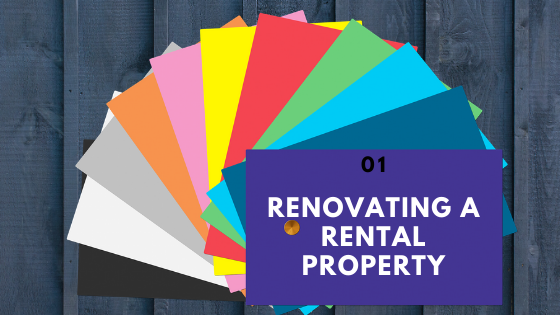An Investor’s Guide to Renovating a Rental Property
Even though it requires spending money, renovating your rental today can yield you a healthy return tomorrow. Successful rental properties share a common formula – they are clean, functional, simplistic and honest.
To maximise your best return and rental income, present your property at the highest standard achievable within your budget. Consider your target market and how best to meet their needs.
There are two main rules you should consider when planning a renovation.
- Don’t renovate a rental property as if you are renovating your own home.
- Less is more. Remember, the property needs to be a blank canvas that tenants can move into and make their home. The more landlords cater to their own taste, the less likely the property will suit others.
Here are some hints and tips that you may find helpful if you’re considering a renovation to your rental property.
First Things First
Make a list of what areas require an upgrade in order of priority and do up a budget of what you can comfortably spend. First impressions count, so when prioritising, be mindful of the first things potential tenants will see when they arrive to view the property. Allocate a portion of your budget for contingencies. This is essential as renovations rarely run to plan and unexpected problems and costs can arise at any time.
You can always feel free to run your plans past our property management team. They are always happy to help and advise on what features make for a successful rental property that is attractive to tenants and thereby helping to ensure any vacancy is minimised.
Carefully select your trades people. Our property management team can also make suggestions to landlords, since most property managers know tradies with references who are reliable and usually competitively priced. Ask for copies of your tradies’ Certificate of Currency for insurance particulars and check that they are adequately covered.
Obtain quotes and choose your builder then finalise your budget and timeline for completion. Your builder can assist you in obtaining any necessary documentation from the Council if and when it becomes relevant. It’s important to make sure your property is compliant with building standards and is certified in line with those requirements. This will be particularly critical if you sell the property in the future.
The time it takes to do the work is vital as even though the benefits will be increased returns once completed, the property will be vacant while the work is done so no rental income will be received during the time it takes to complete the work.
Bang for Your Buck
What kind of work should you do to your property? It can range from basic updating and improvements to a full overhaul and modernisation of the house and it depends entirely on your budget and what you can comfortably afford to do while being careful not to over capitalise when you weigh up what you spend against the rent you are likely to receive and the potential re-sale value of the property.
Rework the floor plan
Reconfiguring a property can be worthwhile whether it’s taking out an old bath to create a more generous bathroom or removing a wall to open up and create a more spacious living area. Another room can add value and maximise returns with bedrooms adding the most value followed by an extra bathroom or more car parking space if that’s at a premium.
Granny flats or a secondary dwelling are popular these days and can double the rental yield of your property by allowing multiply tenants to live in self-contained areas. These will, of course, be subject to approval by your local Council so it is recommended to have all the proper approvals in place if you wish to do this.
Fixture Overhaul
Shiny new taps, shower heads (water efficient of course!) and new handles on doors, vanities, kitchen cabinets and cupboards are styling no-brainers and will instantly lift the look and feel of a room. Update light fittings and make sure that the doors and windows have good quality locks. All of these are simple to achieve and will lessen maintenance issues in the future. They are also make your property more attractive to tenants and give you the edge over other properties being advertised for rent.
Stick with simple pieces that aren’t too fussy as they will have the most appeal to a broad range of tenants. Places like Bunnings often have a broad range of contemporary styles at low prices.
Flooring
New floors are a great way to freshen up a property and there are so many budget friendly and durable options to choose from. Floorboards are great for stylish durability and timber-look vinyl flooring is hugely popular being both attractive and hard wearing.
Replace worn carpet with a good quality fade and stain resistant carpet. Steer clear of flooring like glossy tiles which show every bit of dust and are much harder to keep looking nice.
If you are planning to replace the carpet it is a good time to have the floor inspected by a professional because if it needs any repairs, it’s a great time to take care of it. It may seem obvious but always leave the carpets replacement until the end. Even the most careful painter with drop-sheets can make a mess.
Fresh Paint
Rental properties are most often viewed vacant so a good first impression is crucial. For a quick and effective update, a fresh coat of paint is perfect. Stick with neutral colours and use a flat finish on the walls and go for a semi-gloss on skirting, doors, architraves and windowsills.
Don’t forget to install door stoppers behind all the doors to help preserve the newly painted walls.
Window Treatments
Use simple window treatments to block out light, keep in heat in winter and block out heat in summer, conceal ugly frames or hide an ordinary view. Stores like Spotlight and Bunnings often have a large range of blinds and curtains that are ideal and not too expensive.
Kitchens
Who doesn’t love a fresh, modern looking kitchen? This is one area of your renovation where it’s worth spending as much as you can afford.
Try to use bench tops that are heat, scratch and stain resistant and have good warranty periods. Good quality laminates are hard wearing and affordable. Engineered stone bench tops are also a good alternative and are a stylish and popular choice, although more costly than laminate. Avoid timber bench tops as even though it can look lovely it is high-maintenance and if not properly or regularly sealed can absorb moisture leaving stains or swelling.
Allow for plenty of power points in the splash back and/or cupboards and island bench if there is one. Tiling your splash back is an affordable option but keen in mind you may have maintenance issues down the track with regrouting stained and deteriorated grout. Glass splash backs are a good, though slightly more expensive, option as they are easy to clean with less future maintenance. As always, keep colours neutral and simple.
Choose kitchen cabinetry finishes that aren’t susceptible to showing up fingerprints and food splashes (try to avoid a glossy/shiny look). Keep the colours neutral; they are less likely to date and tenants can add colour with their accessories. Avoid dark colours if your kitchen is a little pokey, and make sure you have good lighting.
Look for cooking packages when buying your appliances. If your builder or kitchen design company can source them, let them. They can usually get better deals than the general public and can more efficiently coordinate the delivery and installation of the items to fit in with their schedule.
Make sure to lay your kitchen flooring between strip-out and installation.
Bathroom Update
For simple and effective updates replace old shower curtains with fresh white ones or update glass screens so they open and close easily and look fresh and clean. Fresh new tiles, a clean vanity, toilet, shower and bath with good quality tapware have a huge impact and longevity. Proper exhaust fans to extract steam are essential in avoiding mould build-up.
If you’re going for a complete overhaul with new everything, remember to stick with neutral tones that look fresh and clean. Don’t go crazy with patterns or colours that will date and keep function and ease of cleaning in mind when choosing fittings and finishes. Layout is also important so take guidance from your builder to maximise the features of the bathroom in the space you have available.
Finally, don’t be afraid to ask questions of your tradies throughout the renovation process. Renovating is a fantastic learning curve that you will certainly benefit from if you renovate again in the future.



